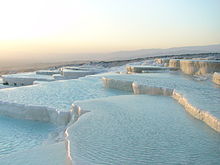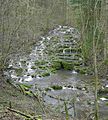Sinter

Sinter (from Old High German sintar 'slag'; in geomorphology also Dauch ) is the substance or rock that is created by a gradual mineral deposit ("sintering"), especially a lime deposit .
Emergence
Sinter is formed by the deposition ( crystallization ) of minerals dissolved in water, i.e. in bodies of water, water pipes and containers or in a humid environment. It forms crust-like coatings
- in the field - on slopes, steps or terraces ( sinter terrace )
- and arises in the most varied of forms in caves , mines and moist tunnels as speleothem (cave sinter ) , from sintered skins to mighty banks .
Chemically, it is non-specific to alkali - and / or alkaline earth metal - salts of various inorganic , but also organic acids along with various admixtures. Petrologically , sinter belongs to the sedimentary group . In biology, sinter is called incrustation .
The chemical processes involved in the formation are described in detail under water hardness # lime-carbonic acid balance .
Shapes of the material

- Mineral deposits in nature of relatively pure composition:
- Lime sinter , which mainly consists of calcium carbonate ( e.g. travertine / tufa )
- Pebbles are sintered from cryptocrystalline silicon dioxide or opal , whichcan be depositedon hot springs (e.g. geysers ) and is sometimescalled geyserite
- Sulfur sinter , mainly various sulphides and sulphates , often the result of volcanic processes
- Mineral characteristics such as quartz veins in other rocks, agate , drusen (geodes)
- Strictly speaking, salt rocks ( evaporites ) , especially rock salt (halite), are also sinter, but the term is not used here.
- the concretion , a incurred by precipitation stone, such as bog iron or hollow beads (also warts Inter called)
- the crusts that form on stone, clay, metallic and other archaeological artifacts that have been in the ground or in the sea for long periods of time
- Sinter in the true sense of the word is used in technology:
- the deposits in pots, pipes or hot water boilers ( boiler scale )
- Urine stone
- Tartar
- An iron oxide mixture is also known as sinter , which is produced in the steel industry when hot steel surfaces come into contact with spray water.
- Sinter, sintered skin or lime sintered skin also refers to the fine crystalline layer a few micrometers thick that is created by evaporation and forms on drying plaster or inorganically bound paint, see also fresco .
Subterranean calcareous sinter formation in a damp tunnel ; similar in old walls and cracked concrete
Sinter deposits on a Roman aqueduct
Lime sinter terrace in Unterdrackenstein (Swabian Alb)
Lime sintering stages of the Lillach near Weißenohe (Franconian Switzerland)
Special natural occurrences
- Stalactites and other speleothem shapes
- porous travertine , tufa limestone (e.g. on the Plitvice Lakes )
- Stone gutters and other relatively compact, finely layered shapes ( growing rock on the Isar)
- Sinter steps (sinter terraces) as a water form (Plitvice Lakes, Pamukkale , Saturnia , Mammoth Hot Springs and many more)
- The occurrence of Böttinger marble in the Swabian Alb Geopark
- The aqueduct marble , as a sintered product of a Roman aqueduct in the Eifel
- Hot spring stone deposits of Karlovy Vary
- artificial reefs
Economic use
Since the first half of the 19th century, sintering has been used by the Fontaines pétrifiantes de Saint-Nectaire company in the French town of Saint-Nectaire for the production of objects. For example, reliefs are produced .
See also
- Carbonate-silicate cycle , the chemistry of sinter formation
Web links
Individual evidence
- ^ Radim Kettner : General Geology . Volume 2: Composition of the earth's crust, formation of rocks and deposits . Berlin 1959, p. 98.
- ^ Johannes Baier: Karlsbad - city of thermal baths and sinter. Fossils 30, 24-28, 2013.
- ^ Johannes Baier: Goethe and the thermal springs of Karlovy Vary (Karlsbad, Czech Republic) . - Jber. Middle Upper Rhine. geol. Ver., NF 94, 87-103, 2012.
- ↑ Philippe Gloaguen, et al .: Le Routard - Le guide de la visite d'entreprise . No. 79/0425/0 . Hachette Livre, Vanves 2016, ISBN 978-2-01-323703-1 , pp. 236 f .





